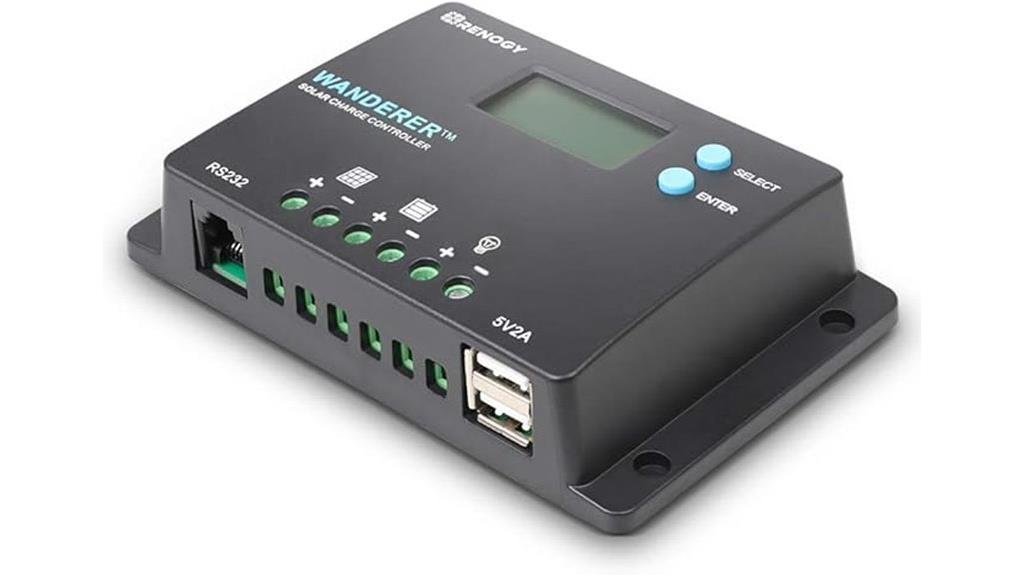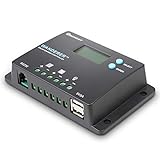When I first encountered the Renogy Wanderer 10A, I was intrigued by its compact design and promised efficiency. It claims to enhance battery lifespan considerably, which is a bold statement for a solar charging controller. With a user-friendly LCD display and a decent market rating, I couldn’t help but wonder if it truly lives up to the hype. Let’s take a closer look at what makes this device stand out—and where it might fall short.
Product Overview and Specifications
When it comes to solar charge controllers, the Renogy Wanderer 10A stands out with its compact design and impressive specifications.
Measuring just 5.2 x 3.1 inches and weighing only 4.32 ounces, it’s perfect for tight spaces. The LCD display provides real-time data on voltage, current, and system status, making monitoring effortless.
It supports various battery types, including AGM, Gel, Flooded, and Lithium, ensuring versatility. Plus, the USB charging port is handy for devices.
With an IP32 waterproof rating, it’s built to withstand outdoor conditions, giving me confidence in its reliability for my off-grid adventures.
Charging Technology and Efficiency
The Renogy Wanderer 10A employs smart 4-stage charging technology that greatly boosts battery life and solar efficiency.
With its Bulk, Boost, Floating, and Equalization stages, I’ve noticed my batteries last around 30% longer compared to basic controllers. The self-consumption rate is impressively low at under 10mA, ensuring maximum output from my solar panels.
I appreciate the advanced load management features that allow for manual, automatic, or timed control modes, giving me flexibility in how I use my energy.
System Protection and Safety Features
One standout feature of the Renogy Wanderer 10A is its extensive system protection and safety measures. This controller safeguards my setup against common issues like overcharging and short-circuiting, which gives me peace of mind. Plus, the negative ground design boosts safety considerably. Here’s a quick look at its key protections:
| Feature | Description | Benefit |
|---|---|---|
| Overcharging | Prevents excessive voltage | Extends battery lifespan |
| Over-discharging | Stops deep discharge | Protects battery health |
| Short-circuit | Cuts power in case of faults | Enhances safety |
| Reverse polarity | Guards against wrong connections | Minimizes damage |
| Temperature compensation | Adjusts charging based on temp | Optimizes performance |
User Experience and Monitoring
Having confidence in the Renogy Wanderer 10A’s safety features allows me to focus on its user experience and monitoring capabilities.
The backlit LCD provides real-time data on voltage, current, and system status, making it easy to track performance. I appreciate the RS232 port for connecting to the Renogy DC Home App via the BT-1 Bluetooth module, enhancing my monitoring experience.
While setup is straightforward, I’ve noticed some users mention the small display size and button responsiveness issues. However, the ability to define charging voltages for LiFePO4 batteries adds great flexibility, making it a solid choice for my solar needs.
Customer Reviews and Market Position
While exploring the Renogy Wanderer 10A, I found that it boasts a solid customer rating of 4.3 out of 5 stars from over 6,800 reviews, which speaks volumes about its popularity.
It ranks #1 in Renewable Energy Controllers, showcasing its market position.
Here are some highlights from customer feedback:
- Praised for affordability and reliability in small off-grid systems.
- Mixed reviews on battery voltage accuracy, especially with temperature integration.
- Users appreciate its compact design and easy setup.

